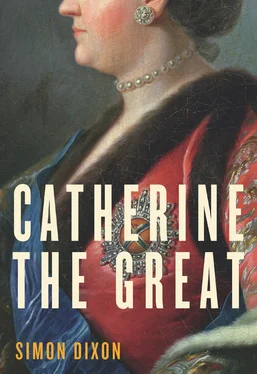A different investigation was begun in the following year when Nikolay Novikov again fell under suspicion. After the raids on his shops in 1787, the cautious publisher had issued very few radical occult books and spent more time at his family estate at Avdotino, forty miles east of Moscow. But since his efforts at famine relief were combined with a determination to improve the profitability of the estate, critics accused him of using Masonic philanthropy as a smokescreen for the exploitation of his peasants. Though Catherine initially wanted Novikov to defend himself against such charges in a court of law, the Governor General of Moscow, Prince Prozorovsky, persuaded her to have him sent under armed guard to the fortress at Schlüsselburg. There he was questioned by the widely feared prosecutor Sheshkovsky and sentenced to fifteen years’ imprisonment on 1 August 1792. Although the interrogation was based on twelve points raised by the empress herself, her motivation remains uncertain. Was it pressure from the Holy Synod that inclined her to make an example of this Rosicrucian heretic? Was it his links with the Prussian-based Masons who surrounded Grand Duke Paul? Why was it that Novikov, rather than his many collaborators, was singled out for persecution? 69
In the absence of definitive answers to such questions, Novikov’s arrest and imprisonment seem best interpreted as part of a wider pattern of increasingly visceral (and increasingly erratic) responses to the challenges of the revolutionary era. It was not an easy time for Europe’s sovereigns. Joseph II had died in 1790; his brother, Leopold II, unexpectedly followed him to the grave two years later. Within less than a month, Catherine was horrified to learn that Gustav III of Sweden had been shot by a disgruntled aristocrat at a masked ball on 5 March 1792 (the incident inspired Verdi’s Un ballo in maschera ). Small as her respect for Louis XVI had been, she was completely disconcerted by his execution on 21 January 1793NS—by a macabre coincidence, the anniversary of the execution of Pugachëv in 1775. After retiring to bed, Catherine remained out of the public eye until 1 February, when she emerged to proclaim six weeks of mourning at Court. All relations with the revolutionary regime in Paris were broken off. 70
The empress’s inveterate English critic Horace Walpole was sure that the wrong monarch had died:
Oh! that Catherine Slay-Czar had been Queen of France in the room of Antoinette—I do not say it would have been any security for her husband’s life; but it would have saved thousands and thousands of other lives, and preserved the late new, amiable and disinterested Constitution of Poland—Well, that Fury of the North has barefaced her own hypocrisy—She pretended to give a code of laws to her ruffians, and to emancipate their slaves; and now plunges the poor Poles again into vassalage under a vile system. 71
Although the Polish question remained in most respects as complex as ever—not least as a result of the confessional heterogeneity of some parts of the population 72—there was one sense in which Catherine’s options had been simplified by Potëmkin’s demise. By the end of his life, there were almost a quarter of a million people on his Polish estates around Śmila, on the River Dnieper, which he was widely suspected of wanting to transform into a feudal principality. After his death, Catherine could pursue his ambitions for a further partition without fear of a rival power base. 73Having signalled her intention to intervene in Poland in February 1792, she seized her chance in May when a group of Polish reactionaries, with Russian support, appealed to her to restore Polish liberties at the Confederation of Targowica, a town in eastern Poland. As many as 100,000 Russian troops soon overwhelmed the Polish resistance that helped to justify their intervention. Now the way was open for a second partition, shared between Russia and Prussia. ‘My part is sung,’ wrote Catherine to Rumyantsev when the Prussian alliance was sealed in November, ‘It is an example of how it is not impossible to attain an end and to succeed if one really wills it.’ 74Handicapped by the French declaration of war in August 1792, the Austrians, having unwisely consented to Prussian gains in Poland in the false hope of exchanging Belgium for Bavaria, were left to seek compensation from France by the deal agreed in January 1793 which gave Russia most of eastern Poland and a further 3 million subjects, including, for the first time, a significant number of Jews. 75Now that Stanislaw August’s dreams of autonomy had been shattered, the final dismemberment of his kingdom could not be long postponed. When Tadeusz Kościusko led an insurrection against the Russian plenipotentiary in March 1794, all three eastern powers combined to suppress it. Initially delayed by the threat of another war with the Turks, Catherine sent Suvorov into Poland in August. On 4 November, he stormed Praga, a suburb of Warsaw, butchering between 13,000 and 20,000 Poles. After that, Zavadovsky predicted to Rumyantsev that ‘the impending partition’ would be straightforward enough: ‘Our neighbours, in their current exhaustion, are in no state to swagger.’ 76So it proved. On 24 December 1794, the third partition removed the name of Poland from the map of Europe, giving the Russians 120,000 square kilometres of new territory, by comparison with 48,000 for Prussia and 47,000 for Austria. In celebration, Catherine granted 107,000 Polish serfs to her closest advisers, 13,199 of them to Platon Zubov. 77
Though the empress never totally rejected French ideas—a luxurious edition of Bayle’s Dictionary , which she had first read at the beginning of the 1750s, was on the list with Plutarch among her last orders from Johann Weitbrecht, the leading bookseller in St Petersburg—she did little to conceal her growing pessimism. 78Faced with revolutionary death threats from France in April 1792, she complained to Grimm that ‘it is apparently a good thing to assassinate people at the end of the eighteenth century, and I am told that it is Voltaire who preached this. See how they dare to cast calumnies on people: I think Voltaire would rather stay where he is buried than find himself in the company of Mirabeau’. By February 1794, however, she told Grimm that he had been right to distance himself from the philosophes , whose work had ‘served only to destroy’. In April she went further: ‘I remembered yesterday something you have said to me more than once: that this century has been a century of preparation.’ Now that preparation seemed only to have led to ‘filth’ of every kind, with the prospect of ‘calamities without end and innumerable wretched people’. 79In such a climate, the moderate Russian writers whose careers Catherine had done so much to foster found themselves under increasing suspicion. A year after the assassination of Louis XVI, even Shakespeare’s Julius Caesar was removed from the bookshops because it dealt with regicide. Catherine’s last significant piece of legislation was the edict of 11 October 1796 which revoked the right of individuals to operate private presses, granted in 1783. Anxious as she had been to propagate improving ideas, an empress obsessed with obedience not only baulked at the growth of independent publishing but was unable to conceive of an orderly system of censorship for the private presses. Twelve of the sixteen closed overnight. Whereas 320 secular books had been published in Russia in 1796, only 212 appeared in the first year of Tsar Paul’s reign, the lowest total since 1777. 80
* * *
Although the empress’s view of the Enlightenment had undergone a marked transformation since her patronage of Voltaire and Diderot in the 1760s, little in her daily routine had changed. Sitting in her study every morning, she continued to dispatch business just as she had done throughout her reign. One of her secretaries’ jobs was to process the petitions submitted in her name. Of the 1920 submitted to the chancellery directed by Dimitry Troshchinsky and Adrian Gribovsky between January 1795 and 4 November 1796, two thirds (1036) were from nobles. Merchants (119) constituted the next largest group; 85 came from non-noble officials and army officers; 66 were from peasants, 46 from foreigners and 12 from the empress’s own Court servants. Of the noble petitions, the greatest number (147) concerned disputes over estates, with 56 more to do with squabbles over land. Few such documents reached the empress as a result of the draconian legislation against false petitions and official attempts to limit their number—on her trip to the South in 1787, the archbishop of Yekaterinoslav had strictly forbidden his clergy from daring to appeal to her directly (they were not to go near the palace, still less lurk outside her windows). 81Of those petitions she scrutinised, however, a fair number seem to have received a positive response: of the 133 requests for aid in these two years, 74 were granted and so were 48 of the 61 requests for pensions. 82
Читать дальше












